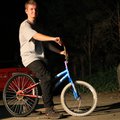-
Hack Chat Transcript, Part 2
08/21/2019 at 20:03 • 0 comments![]() (the signs in the court yard is my favorite piece)
(the signs in the court yard is my favorite piece)![]() Do you need any sort of security clearance for the work that you do ?
Do you need any sort of security clearance for the work that you do ?![]() would imagine they're part of the media dept.
would imagine they're part of the media dept.![]()
https://www.jpl.nasa.gov/thestudio/
The Studio at JPL
The Studio is a team of designers, artists, makers, strategists, and thinkers. We are passionate about helping scientists and engineers imagine the future, and giving people a sense of awe about the universe.
![]() Not for the work I do
Not for the work I do![]() @morgan oh yeah! I have not work with the studio, but I'm a fan :)
@morgan oh yeah! I have not work with the studio, but I'm a fan :)![]() Did most people who work at JPL go to top unis?
Did most people who work at JPL go to top unis?![]() eh
eh![]() What software management tool(s) do you use?
What software management tool(s) do you use?![]() I know an engineer at JPL who went to UC Merced, so not sure uni matters
I know an engineer at JPL who went to UC Merced, so not sure uni matters![]() there are lots of folks from MIT, Caltech, etc.. but there are also folks like me from Cal Poly Pomona or whatever. Uni doesn't matter IMO
there are lots of folks from MIT, Caltech, etc.. but there are also folks like me from Cal Poly Pomona or whatever. Uni doesn't matter IMO![]() I brought a bunch of PCBs and robots to my interview
I brought a bunch of PCBs and robots to my interview![]() figured results speak louder than "i passed ECE 405"
figured results speak louder than "i passed ECE 405"![]() Nice!
Nice!![]() @James Finch we have a lot of in house tools, but generic things like MS Projects and JIRA are used too
@James Finch we have a lot of in house tools, but generic things like MS Projects and JIRA are used too![]() Are the change control processes still paper based or are they migrated to software apps?
Are the change control processes still paper based or are they migrated to software apps?![]() Oh no, JIRA... *Your board has been updated [refresh]*
Oh no, JIRA... *Your board has been updated [refresh]*![]() software with paper backup
software with paper backup![]() custom in-house tools are a double edge sword. They allow for flexibility, but that also means that they can grow into these complex UX nightmares
custom in-house tools are a double edge sword. They allow for flexibility, but that also means that they can grow into these complex UX nightmares![]() I should also mention, the 'prototype' project im working on
I should also mention, the 'prototype' project im working on![]()
https://www.youtube.com/watch?v=z6PzGLcd_Io
![]() oh, shiny!
oh, shiny!![]() Woah
Woah![]() Awesome! :D
Awesome! :D![]() It's called LLAMA. We build Rev 1.0 back in October and we are almost done building Rev 2.0, so you should be seeing a press release on that soon
It's called LLAMA. We build Rev 1.0 back in October and we are almost done building Rev 2.0, so you should be seeing a press release on that soon![]() built*
built*![]() Nice!
Nice!![]() This was actually the first project i've worked on here where I got a chance to drastically improve the design of something.
This was actually the first project i've worked on here where I got a chance to drastically improve the design of something.![]() what's the use case?
what's the use case?![]() You're partnered with ARL?
You're partnered with ARL?![]() What did you drastically improve the deisgn of?
What did you drastically improve the deisgn of?![]() What did you improve on it?
What did you improve on it?![]() We typically build one-off prototypes, but for this task we got to do the whole "I wish i changed that part and optimized that thing"
We typically build one-off prototypes, but for this task we got to do the whole "I wish i changed that part and optimized that thing"![]() I can't speak much about it yet, but at a very high level we made it less heavy and improved the power management /data system
I can't speak much about it yet, but at a very high level we made it less heavy and improved the power management /data system![]() this is so cool
this is so cool![]() Sweet
Sweet![]() @de∫hipu robotic mobility research for us. this is probably JPL's first truely dynamic robot.
@de∫hipu robotic mobility research for us. this is probably JPL's first truely dynamic robot.![]() from the existence of fans I guess it's only good in Earth atmosphere
from the existence of fans I guess it's only good in Earth atmosphere![]() we like to build quazi-static robot which perform very calculated movements
we like to build quazi-static robot which perform very calculated movements![]() I.e.- Robosimian
I.e.- Robosimian![]() Do you see a quadruped robot as a viable platform for planetary exploration? As opposed to wheeled vehicles
Do you see a quadruped robot as a viable platform for planetary exploration? As opposed to wheeled vehicles![]()
https://www.youtube.com/watch?v=3u1o8HjwGcU
![]() Wow
Wow![]() I love the design of robosimian, I think the Interstellar would be a much better movie if the robots there were like that
I love the design of robosimian, I think the Interstellar would be a much better movie if the robots there were like that![]() Oh man, yeah I agree
Oh man, yeah I agree![]() instead of those ridiculous black obelisk defying laws of mechanics
instead of those ridiculous black obelisk defying laws of mechanics![]() @Dan Maloney Yeah, one research path is asteroid/low-gravity body interactions where you have to be dynamic
@Dan Maloney Yeah, one research path is asteroid/low-gravity body interactions where you have to be dynamic![]() Yeah i dont understand the interstellar robots
Yeah i dont understand the interstellar robots![]() I understand how they didn't want to have humanoids (sorry for OT)
I understand how they didn't want to have humanoids (sorry for OT)![]() Learning from mission issues, are these designs moving in the direction of how to not get stuck? Maybe climbing potential?
Learning from mission issues, are these designs moving in the direction of how to not get stuck? Maybe climbing potential?![]() YES!
YES!![]() Hi @arko can you please get me a ticket to Mars? kthx
Hi @arko can you please get me a ticket to Mars? kthx![]() Looking at the progression in rovers in the picture earlier. Next one should be SUV sized with 24" wheels
Looking at the progression in rovers in the picture earlier. Next one should be SUV sized with 24" wheels![]() Only if you're a robot.
Only if you're a robot.![]() whoa samys here
whoa samys here![]() Well, we typically define the robots requirements up front and design against that.
Well, we typically define the robots requirements up front and design against that.![]() so if there's a 45 deg slop and we can only operate on 40deg max, we just dont do it
so if there's a 45 deg slop and we can only operate on 40deg max, we just dont do it![]() Do you work with exotic materials for the parts used in the prototypes?
Do you work with exotic materials for the parts used in the prototypes?![]() Neat!
Neat!![]() @samy kamkar lol, the best I can do is https://mars.nasa.gov/participate/send-your-name/mars2020/
@samy kamkar lol, the best I can do is https://mars.nasa.gov/participate/send-your-name/mars2020/![]() I loved the lemur series, I wondered what happened to them
I loved the lemur series, I wondered what happened to them![]() I was expecting a jumping robot. That thing looks intense.
I was expecting a jumping robot. That thing looks intense.![]() @James Finch I personally haven't, but i know folks here who are always using these wackly materials. I feel like i learn about a new material every week
@James Finch I personally haven't, but i know folks here who are always using these wackly materials. I feel like i learn about a new material every week![]() bonus points when the wacky material is available on Mcmaster
bonus points when the wacky material is available on Mcmaster![]() off the top of my head, i recall Mars Pathfinder using memory wire
off the top of my head, i recall Mars Pathfinder using memory wire![]() shape-memory alloy that is
shape-memory alloy that is![]() Last few minutes here for me before going back to work
Last few minutes here for me before going back to work![]() :-) That would be awesome to experience. Wondering about electronics components also if there are proprietary materials the main stream consumer doesn't see much if at all. Any neat materials most don't see?
:-) That would be awesome to experience. Wondering about electronics components also if there are proprietary materials the main stream consumer doesn't see much if at all. Any neat materials most don't see?![]() @arko, Thanks so much for taking time out of your schedule to do this, this was incredibly cool and I learned a lot, maybe we'll cross paths somewhere down the line again!
@arko, Thanks so much for taking time out of your schedule to do this, this was incredibly cool and I learned a lot, maybe we'll cross paths somewhere down the line again!![]() Nice, memory alloys.
Nice, memory alloys.![]() Awesome talk arko and cool channel :)
Awesome talk arko and cool channel :)![]() I'll be around online again after 3:30 if you have more questions. As always, folks are welcome to DM or ask questions via email ara.kourchians@jpl.nasa.gov
I'll be around online again after 3:30 if you have more questions. As always, folks are welcome to DM or ask questions via email ara.kourchians@jpl.nasa.gov![]() Yeah, thanks arko!
Yeah, thanks arko!![]() really cool talk @arko thanks so much :)
really cool talk @arko thanks so much :)![]() :) thanks for having me! this was so much fun!
:) thanks for having me! this was so much fun!![]() Thanks arko!
Thanks arko!![]() you all asked great questions :) my fingers hurt
you all asked great questions :) my fingers hurt![]() I'm also on twitter @arkorobotics if you have questions and I'm not online here
I'm also on twitter @arkorobotics if you have questions and I'm not online hereThank you @arko :-) Keep up the good work! :-)
![]() Thank you very much @arko
Thank you very much @arko![]() cheers!
cheers!![]() Hey Arko, you beat me to my wrap up! Thanks for hanging out with us today, we really appreciate it. Now that we're all jealous of your gig, I imagine they'll see some resumes coming in ;-)
Hey Arko, you beat me to my wrap up! Thanks for hanging out with us today, we really appreciate it. Now that we're all jealous of your gig, I imagine they'll see some resumes coming in ;-)You have new follower or Twitter @arko :-)
![]() Haha! We are always looking for hackers and tinkerers
Haha! We are always looking for hackers and tinkerers![]() <3
<3![]() Thanks everyone else too for coming along for the trip. And don't forget that next week we have an update from Parallax with Ken and Chip Gracey - https://hackaday.io/event/165855-parallax-update-hack-chat
Thanks everyone else too for coming along for the trip. And don't forget that next week we have an update from Parallax with Ken and Chip Gracey - https://hackaday.io/event/165855-parallax-update-hack-chat![]()
-
Hack Chat Transcript, Part 1
08/21/2019 at 20:02 • 0 comments![]() Hi everyone, welcome to the Hack Chat. It's time for us all to learn about what for a lot of us would be a dream job - working at the Jet Propulsion Lab. Arko joins us today to talk about what it's like to be a robotics engineer at JPL.
Hi everyone, welcome to the Hack Chat. It's time for us all to learn about what for a lot of us would be a dream job - working at the Jet Propulsion Lab. Arko joins us today to talk about what it's like to be a robotics engineer at JPL.Welcome Arko! Can you start us off with a little about your background?
![]() Howdy everyone!
Howdy everyone!![]() Hello
Hello![]() Hello
Hello![]() Sure! I'm an electrical engineer with a BS from Cal Poly Pomona. I have 12+ years in circuit design, robotics, and random hackery things.
Sure! I'm an electrical engineer with a BS from Cal Poly Pomona. I have 12+ years in circuit design, robotics, and random hackery things.![]() Worked on many projects ranging from Mars rovers to DeLorean Time Machines.
Worked on many projects ranging from Mars rovers to DeLorean Time Machines.![]() Is there any way for someone with years of professional software experience to get a job working at JPL even if they don't have a degree?
Is there any way for someone with years of professional software experience to get a job working at JPL even if they don't have a degree?![]() For more info, I have a short portfolio online: http://arkorobotics.com/portfolio.html
For more info, I have a short portfolio online: http://arkorobotics.com/portfolio.html![]() Nice
Nice![]() Aw yeah, you have FRC on your site!
Aw yeah, you have FRC on your site!![]() Hmmm good question... I personally don't know of any SW engineers without a degree and it maybe that there's a policy on having a degree. I would suggest reaching out to our HR department for a better answer: https://jpl.jobs/
Hmmm good question... I personally don't know of any SW engineers without a degree and it maybe that there's a policy on having a degree. I would suggest reaching out to our HR department for a better answer: https://jpl.jobs/![]() Oddly enough, some of the best SW engineers I know don't have degrees...
Oddly enough, some of the best SW engineers I know don't have degrees...![]() What's been your favorite project at JPL?
What's been your favorite project at JPL?![]() @Christopher Bero Yes! I was part of Team 589 for all 4 years of high school and went back to mentor :)
@Christopher Bero Yes! I was part of Team 589 for all 4 years of high school and went back to mentor :)![]() Ok cool.
Ok cool.![]() Nice!
Nice!![]() hmmm, I'd have to say the Mars 2020 Rover's Lander Vision System:
hmmm, I'd have to say the Mars 2020 Rover's Lander Vision System: ![]() That looks like a pretty intense setup.
That looks like a pretty intense setup.![]() I had the opportunity to fly in a helicopter at 17000ft to test hardware destined for mars.. so that has to be my favorite (so far!): https://twitter.com/arkorobotics/status/1132341128848498688
I had the opportunity to fly in a helicopter at 17000ft to test hardware destined for mars.. so that has to be my favorite (so far!): https://twitter.com/arkorobotics/status/1132341128848498688![]() Yeah, we packed *a lot* of hardware into that helicopter
Yeah, we packed *a lot* of hardware into that helicopter![]() What would you say is the best project that has already been launched?
What would you say is the best project that has already been launched?![]() DeLorean Time machine???
DeLorean Time machine???![]() For context, we designed and developed a very powerful flight computer/vision system for the M2020 Rover (https://mars.jpl.nasa.gov/mars2020/mission/technology/entry-descent-landing/) so that it can figure out where it is during landing and to divert away from hazards
For context, we designed and developed a very powerful flight computer/vision system for the M2020 Rover (https://mars.jpl.nasa.gov/mars2020/mission/technology/entry-descent-landing/) so that it can figure out where it is during landing and to divert away from hazards![]() Sweet
Sweet![]() We packed an engineering model of the flight hardware and a bunch of "ground support equipment" hacks into the helicopter as well as a gimbal with a camera and IMU on it
We packed an engineering model of the flight hardware and a bunch of "ground support equipment" hacks into the helicopter as well as a gimbal with a camera and IMU on it![]() and used the gimbal to simulate the parachute motions during descent.
and used the gimbal to simulate the parachute motions during descent.![]() Nice
Nice![]() Were you testing more of the algorithms that will be used for landing or the actual hardware that will fly on the mission too?
Were you testing more of the algorithms that will be used for landing or the actual hardware that will fly on the mission too?![]() JPL has this philosophy of "Test as you fly. Fly as you test", meaning you should test your system like how you plan to fly it
JPL has this philosophy of "Test as you fly. Fly as you test", meaning you should test your system like how you plan to fly it![]() and remember to fly as you tested it :)
and remember to fly as you tested it :)![]() @Dan Maloney Great question. It was a full systems test.
@Dan Maloney Great question. It was a full systems test.![]() Up until then, we had tested everything in pieces. So this field test used final flight software and hardware in the most 'flight like' conditions possible
Up until then, we had tested everything in pieces. So this field test used final flight software and hardware in the most 'flight like' conditions possible![]() The actual flight hardware itself is actually already in the rover () and was tested separately
The actual flight hardware itself is actually already in the rover () and was tested separately![]() What has been your hardest proyect to achieve?
What has been your hardest proyect to achieve?![]() more so a hardware design verifcation test (TVAC/EMI EMC/Vibe/Shock)
more so a hardware design verifcation test (TVAC/EMI EMC/Vibe/Shock)![]() what we flew in the heli was a flight replica
what we flew in the heli was a flight replica![]() So 2020 is like the size of a Mini Cooper? Maybe a bit bigger?
So 2020 is like the size of a Mini Cooper? Maybe a bit bigger?![]() @gmarmolburgos hmmm, I'd have to say M2020 was the most difficult overall due to complexity
@gmarmolburgos hmmm, I'd have to say M2020 was the most difficult overall due to complexity![]() Not to say my other tasks haven't been difficult
Not to say my other tasks haven't been difficult![]() :P
:P![]() Thanks 😊
Thanks 😊![]() @Dan Maloney M2020 is the same size (ish) but with more instruments - Humans for scale
@Dan Maloney M2020 is the same size (ish) but with more instruments - Humans for scale ![]() What's the project lifecycle like at JPL? What kind of teams are there? Do you have multiple tasks/projects going at once?
What's the project lifecycle like at JPL? What kind of teams are there? Do you have multiple tasks/projects going at once?![]() Love this question
Love this question![]() How does the component selection process change when designing for environments as harsh as space? What are some surprising things you need to take into account?
How does the component selection process change when designing for environments as harsh as space? What are some surprising things you need to take into account?![]() That's a big rover.
That's a big rover.![]() What would you recommend a high school student to read about if he wants to study aeroespacial engerneering? (Any books or authors you could recommend) (podcasts even)
What would you recommend a high school student to read about if he wants to study aeroespacial engerneering? (Any books or authors you could recommend) (podcasts even)![]() So project lifecycles vary from task to task, as do teams
So project lifecycles vary from task to task, as do teams![]() What programming language has been the most proven to use when making the rovers/probes?
What programming language has been the most proven to use when making the rovers/probes?![]() So JPL, in general, has two types of projects: Flight and Non-Flight
So JPL, in general, has two types of projects: Flight and Non-Flight![]() most folks work Flight only
most folks work Flight only![]() some work Non-Flight only... and there are a few who work both
some work Non-Flight only... and there are a few who work both![]() I happen to be "both". Which can be really challenging from a time management perspective, but it allows me to live in both worlds and to exchange experiences between them.
I happen to be "both". Which can be really challenging from a time management perspective, but it allows me to live in both worlds and to exchange experiences between them.![]() As for teams, again it varies, but my rule of thumb is to pick working with good teams.
As for teams, again it varies, but my rule of thumb is to pick working with good teams.![]() cool tasks come second because... lets face it.. this place is a candy store of tasks. It's hard to find a lame task.
cool tasks come second because... lets face it.. this place is a candy store of tasks. It's hard to find a lame task.![]() Awesome haha
Awesome haha![]() As for component selection, we have an internal catalog of not only known good parts, but designs as well
As for component selection, we have an internal catalog of not only known good parts, but designs as well![]() *Bows down in reverence*
*Bows down in reverence*![]() JPL sounds a bit like nerdvana
JPL sounds a bit like nerdvana![]() Need 5V in your design? Boom, known working design with traceable testing and stocked parts
Need 5V in your design? Boom, known working design with traceable testing and stocked parts![]() workign footprints and schematic, etc
workign footprints and schematic, etc![]() I'm not sure you're allowed to answer this, but who do you guys go to to get your PCB prototypes/finals done
I'm not sure you're allowed to answer this, but who do you guys go to to get your PCB prototypes/finals done![]() Lots of different vendors
Lots of different vendors![]() Huh
Huh![]() Flight tasks require ITAR compliance, so that sorta limits us.
Flight tasks require ITAR compliance, so that sorta limits us.![]() but for prototype projects, I like to use US vendors
but for prototype projects, I like to use US vendors![]() does JPL use some formal verification when programming, like Spark/Ada?
does JPL use some formal verification when programming, like Spark/Ada?![]() hah, Ada
hah, Ada![]() Chinese or American PCB vendors?
Chinese or American PCB vendors?![]() American. Purchasing out of the country is a MAJOR pain and requires justification
American. Purchasing out of the country is a MAJOR pain and requires justification![]() was not Ada's fault that one rocket crashed :-)
was not Ada's fault that one rocket crashed :-)![]() there are formal verification processes
there are formal verification processes![]() lots of code reviews
lots of code reviews![]() for the most part, we use C/C++ for SW and Verilog for HW
for the most part, we use C/C++ for SW and Verilog for HW![]() ^ My favorite talk on Flight SW at JPL
^ My favorite talk on Flight SW at JPL![]() Awesome
Awesome![]() cool, will watch it. But formal verification is very difficult for C, but I guess you use some standard like MISRA C?
cool, will watch it. But formal verification is very difficult for C, but I guess you use some standard like MISRA C?![]() We def do
We def do![]() We use a bunch of tools like coverity for static analysis
We use a bunch of tools like coverity for static analysis![]() and dynamic
and dynamic![]() internal tools too
internal tools too![]() @Frank Buss From wikipedia it looks like: "The NASA Jet Propulsion Laboratory C Coding Standards[6] are based on MISRA-C:2004."
@Frank Buss From wikipedia it looks like: "The NASA Jet Propulsion Laboratory C Coding Standards[6] are based on MISRA-C:2004."![]() you can still do a lot of silly things in C, why not Ada? It is supposed to be much safer
you can still do a lot of silly things in C, why not Ada? It is supposed to be much safer![]() we have a lot of 'lessons learned' from past missions which we incorporate into flight code rules
we have a lot of 'lessons learned' from past missions which we incorporate into flight code rules![]()
https://en.wikipedia.org/wiki/The_Power_of_10:_Rules_for_Developing_Safety-Critical_Code
The Power of 10: Rules for Developing Safety-Critical Code
From Wikipedia, the free encyclopedia Jump to navigation Jump to search The Power of 10 Rules were created in 2006 by Gerard J. Holzmann of the NASA/JPL Laboratory for Reliable Software. The rules are intended to eliminate certain C coding practices which make code difficult to review or statically analyze.
![]() everyone one of these rules traces back to a mission failure
everyone one of these rules traces back to a mission failure![]() Ada's cool, but I'm a Rust person myself :P
Ada's cool, but I'm a Rust person myself :P![]() *waits for fight to ensue*
*waits for fight to ensue*![]() I know that recently a lot of software dev has been moving over to the cloud, is there anything being done using cloud computing at JPL?
I know that recently a lot of software dev has been moving over to the cloud, is there anything being done using cloud computing at JPL?![]() LOSTS
LOSTS![]() Is there anything JPL/NASA publishes that you feel doesn't get seen enough? Cool images or interesting datasets?
Is there anything JPL/NASA publishes that you feel doesn't get seen enough? Cool images or interesting datasets?![]() LOTS*
LOTS*![]() we do more than just code for flight hardware, in fact those teams are much smaller than the other apps we make inhouse
we do more than just code for flight hardware, in fact those teams are much smaller than the other apps we make inhouse![]() hey arko, im not sure how relevant this is to you, but what are your thoughts on the future of RF engineers in the space industry? Would look to work at JPL or NASA one day on their satellites/comms. Currently at an internship in Pasadena lol, literally down the street from JPL.
hey arko, im not sure how relevant this is to you, but what are your thoughts on the future of RF engineers in the space industry? Would look to work at JPL or NASA one day on their satellites/comms. Currently at an internship in Pasadena lol, literally down the street from JPL.![]() love*
love*![]() I cant really speak to it since im not a cloud person :P
I cant really speak to it since im not a cloud person :P![]() @Christopher Bero need to think about that. The JPLRaw youtube channel is pretty cool
@Christopher Bero need to think about that. The JPLRaw youtube channel is pretty cool![]()
https://www.youtube.com/channel/UCYt2JN2z3ZXQpgPHt_eKcTw
JPLraw
JPL Raw is a channel used by NASA's Jet Propulsion Laboratory to deliver on-demand video to news media and others. The majority of video on this channel cons...
![]() I work at Chabot Space and Science Center in Oakland, we take advantage of the JPL assets being available in a lot of our work. From images, to 3d model to code and data
I work at Chabot Space and Science Center in Oakland, we take advantage of the JPL assets being available in a lot of our work. From images, to 3d model to code and data![]() Thanks!
Thanks!![]() Oh, nice!
Oh, nice!![]() And being able to reach out to The Studio has been a great resource in exhibit development
And being able to reach out to The Studio has been a great resource in exhibit development![]() @baldwinngo0813 Nice! I know we are always looking for great RF engineers, I'd recommend applying if you are interested. For background, I applied to JPL 12+ times
@baldwinngo0813 Nice! I know we are always looking for great RF engineers, I'd recommend applying if you are interested. For background, I applied to JPL 12+ times![]() Woah, to different areas inside?
Woah, to different areas inside?![]() sometimes it's just that I didnt have enough experience or that they had already filled the position
sometimes it's just that I didnt have enough experience or that they had already filled the position![]() Ah.
Ah.![]() What was different about the last time (other than getting the job)
What was different about the last time (other than getting the job)![]() @morgan nice!
@morgan nice!![]() @arko do you ever get to do work with The Studio?
@arko do you ever get to do work with The Studio?![]() @Adam Fresh out of college. Timing. Made connections at JPL so I had a foot in the door.
@Adam Fresh out of college. Timing. Made connections at JPL so I had a foot in the door.![]() @morgan Not familiar, you mean the media department?
@morgan Not familiar, you mean the media department?About Us Contact Hackaday.io Give Feedback Terms of Use Privacy Policy Hackaday API
 Lutetium
Lutetium








 Do you see a quadruped robot as a viable platform for planetary exploration? As opposed to wheeled vehicles
Do you see a quadruped robot as a viable platform for planetary exploration? As opposed to wheeled vehicles



